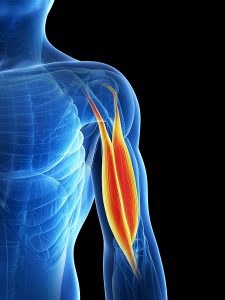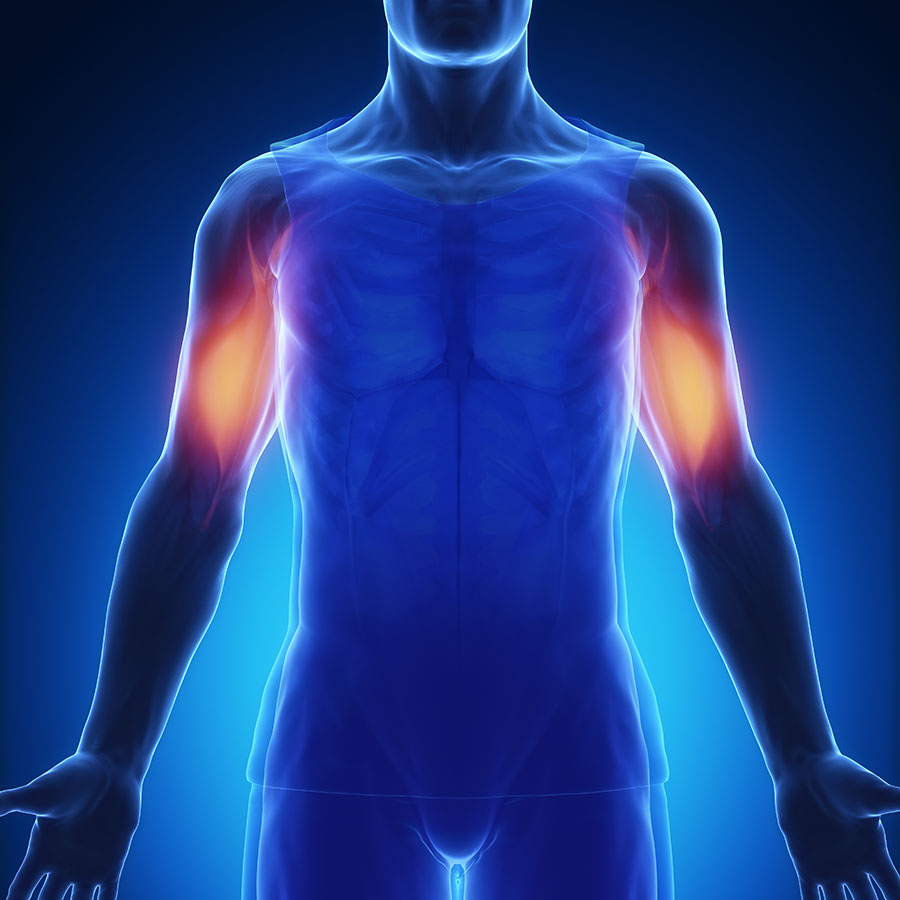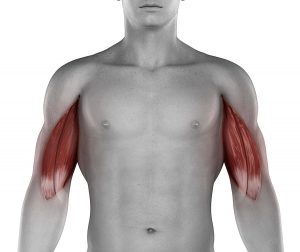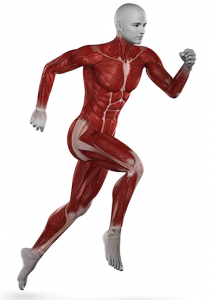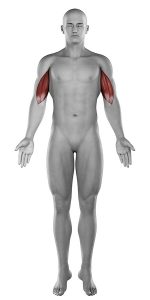The Bicep muscle is the first muscle that you’ll tear when you overload it when lifting heavy things. “Bi” refers to the two distinctive heads where it runs over the front of your upper arm, it anchors over the top of your shoulder and attaches just below your elbow joint. It’s not only vulnerable to overload, but repetitive elbow bending like playing an instrument for a long time (for example the violin) can also strain your biceps muscle. A bicep muscle tear is usually preceded by a tendinitis of your bicep tendon. We take the function of this muscle for granted. However once injured, you’ll realize just how much you actually depend on your biceps brachii muscle. Unfortunately a bicep muscle tear can cause havoc along the rest of your arm, so be sure to take good care of it.
We’ve treated various degrees of torn biceps successfully. If you’re feeling pain when you bend your elbow – let us have a look and determine the damage.
Where is the bicep muscle located?
Normally the bicep muscle has two parts that come from slightly different locations at the shoulder joint. There are some people that have three parts or more but that is very rare. The muscle makes a big belly over the upper arm which can be felt when you bring your wrist to your shoulder. The biceps then runs down the arm and has a strong tendon that connects it to the forearm. It is one of the seven two-joint muscles in the body, which means that it does not only move one joint but your elbow and your shoulder joint as well. This makes the bicep muscle more susceptible for injuries.
What does the bicep muscle do?
The Bicep muscle is responsible for bending the elbow and bringing the hand to the shoulder. It also assists in turning the forearm inwards. This means that it has to be strong while you lift boxes or hold them, pick up a child, assist in arm wrestling.
The biceps can lengthen and still contract, when it needs to control the elbow when your arm straightens. This happens during throwing (as in darts) or in overhead sports such as tennis, cricket or netball.
How does a bicep muscle tear happen?
Overload
A bicep muscle tears when you lift something that is too heavy. The bicep muscle cannot create enough force and so it starts to tear some muscle fibers. If you are into weight lifting you will surely have seen at least one you-tube video of someone tearing a bicep muscle as they attempt to break their personal records.
A sudden strong resistance can also cause the same damage, because the muscle did not contract and was too slow to activate. The force tear the fibers. A typical example of this is when you are moving and your husband hands you a heavy box jokingly saying “Oh honey catch this feather-light box ;)” and while you do not see that he is struggling to carry it, the weight drops onto your arms and SNAP, you feel that muscle talking to you.
Another way to injure the bicep muscle is through throwing something SO hard, that the muscle could not control the straightening of the elbow, which causes it to stretch over its normal length. This can happen when a tennis player serves or when swimming. “Finish the match with a bang”, resonates through your mind as you feel the already fatigued muscle trying to control the high load, after which the pain sets in.
Trauma
You can injure your bicep muscle when bowling or in a rugby match. When the shoulder joint is locked down and someone falls onto your forearm, forcing it straight, your bicep muscle will tear. Most commonly the muscle tears at the musculotendinous junction, where the muscle joins the tendon.
If it is a severe tear, an audible snap can be heard and the muscle might have torn a lot of fibres. Along the muscles, from the shoulder to the elbow it can be painful, blue and swelling will start to appear.
You will notice an increase in temperature around the bicep tear. Bluish discoloration comes from bleeding of the small arteries around the torn fibers of the biceps muscle. The bleeding can also shift to a different location in the arm, for example into the chest or elbow. The bruising will shift depending on how you sleep at night and follow the pull of gravity. So you’ll notice the area of bruising will move more to the back if you sleep on your back, more on the side if you side-sleep, or in the front if you’re a stomach sleeper.
Causes of the bicep muscle strain
Bicep muscle strains happen because of various reasons.
Overuse:
Practicing violin, which requires repetitive low load movements can lead to multiple small bicep muscle strains. Especially if the body is overwhelmed because of long hours of practicing. This high volume of repetitive movements combined with fatigue are a dangerous combination. The risk increases exponentially with every 10 minutes of practice after fatigue starts to set in.
The severe stiffness that you feel after a long session comes from micro-trauma, where a small amount of tears are in the muscle. Now every 10 minutes longer will increase that amount of tearing and the micro-trauma will turn into macro-trauma. This we call a muscle strain or tear.
Overload:
Doing cross-fit with heavy weights, without being used to the extreme increase in load, can tear your bicep muscle. This could also be from lifting heavy furniture or appliances.
The upper arm will be sensitive to touch and certain localized points may be more tender. Those trigger points can also refer into the shoulder region or down into the elbow or lower arm. A very sensitive spot is right on the knob in the front of the shoulder where the shorter part of the bicep muscle attaches.
Sudden Overload:
The sudden drop of a heavy object after anticipating something light may cause discomfort in your bicep muscle. This is a frustrating way to attain an injury seeing as your muscle can technically bear the weight, it simply didn’t expect the load to be heavy and thus delayed the fiber reaction time. You will be able to tell the exact moment your pain started and the exact area where you felt it. Mostly it is a constant discomfort for a couple of days that should be resolved within a few days. It may also happen at the gym when heavy free weights are used, or during quick movements and especially in eccentric training (i.e. negatives).
Overstretch:
After having gymed very hard, your muscles will feel sore and stiff. If you continue training hard under these conditions and try to straighten your elbow quickly, or with a load, without having warmed up properly, the muscle fibers will tear where they were still recovering from the previous work-out. One forceful elbow straightening can also be the reason for an over-stretch, where the triceps (the muscles at the back of your arm) contract stronger than your biceps can control and then this causes the elbow to straighten more than it should. This sort of pain feels like a constant niggle if neglected in Rehab.
Trauma:
A direct blow to the bicep muscle causes the elbow to be forcefully hyper-extended.
Fractures:
The chances of having your bicep muscle torn after an elbow or shoulder fracture is very likely. Sometimes the attention to the fracture overshadows the bicep muscle tear, but when the fracture is healed, you are left with the aftermath of an unhealed tear.
Self test
How bad is your bicep tear?
Grade 2 tear:
- A moderate to significant percentage of fibres are torn, it can vary between 20-80% of the fibres.
- Some pins and needles can be felt down the arm and it is not possible to lift a heavy box; a palpable gap can be felt in the muscle once the swelling has decreased.
- Recovery time: 2-4 weeks according to the percentage of fibres that are torn. A full recovery and returning to sport will take longer and should not be confused with the healing period. To return to the sport can depend on the specific sport, but will only be after 4-6 weeks.
Grade 3 tear:
- The whole muscle is torn off.
- It is also referred to as the Popeye muscle; where the muscle bulk moved down because the bicep muscle tore at the shoulder. When bending the elbow a very visible “Popeye” bicep belly will display.
- Recovery time: 2-3 months non-operatively. Different healing times apply with operations. 4 Months can be an indication if only one part of the bicep is completely torn off. It takes 6-7 months before returning to play if the muscle tore at the elbow joint.
Diagnosis of a torn bicep
We will assess your shoulder clinically, by loading the different muscles to make an accurate diagnosis. Our tests can accurately identify the injured structure (muscle, ligament or joint). To confirm your clinical diagnosis, or rule out other pathology we may refer you for other imaging. A full rupture, grade 3 biceps tear, can be seen with the naked eye. It will look as though your bicep moved down towards your elbow.
Diagnostic ultrasound (sonar)
Sonar imaging will show us the severity and exact location of your bicep muscle tear. It shows all soft tissue, and any other injury to soft tissue structures (rotator cuff) will also be visible.
MRI
A MRI is a costly procedure, requested by a specialist. It will most likely show a shift of the bicep muscle out of its grove where it should be located near the shoulder. If concomitant injuries are suspected in the rotator cuff muscles, an MRI can also be helpful. Another structure that can only be visualized by a MRI is the glenoid labrum, similar to the discs of the spine, which increases the joint surface and plays an important roll in joint pressure. If injury to the labrum is suspected we can refer you to a specialist.
How do we test it?
A comprehensive set of clinical tests will give us the best indication what structures have been injured. The following structures should be included:
- Elbow and Wrist
- Shoulder
- Cervical neck
- The 3 main nerve branches
- Surrounding muscles
Within these joints are different structures that have to be tested for their integrity, the range of movement and strength as well as the length of the muscles.
The following tests are used to determine whether the bicep muscle is strained:
- Speed test (bicep muscle resistance capability)
- Yergason’s test (ligament integrity- bicep muscle still in the groove?)
- Ludington’s test (long head of bicep muscle torn?)
These tests provide information about different structures that could also be involved, such as the labrum which holds the shoulder in the shoulder joint and the ligaments that hold the bicep muscle in the groove.
Why is my bicep tear not healing?
Depending on the severity of your injury, your bicep muscle tear needs adequate rest in the optimal position, responsible loading and progression of exercises in order to heal completely. Complete rest, in a sling, or irresponsible loading, rest – gym – re injure – rest, causes a cycle that is difficult to break. Our bodies are intelligent and able to heal very quickly, but it may not be functional for the goals you have. A muscle tear heals by means of a sort of scab, like a skin laceration. If the scab is dry and too tight it just comes off again. You need to treat your bicep tear in the same way.
What NOT to do
Making the injury worse
A big problem we see with bicep muscle tears
If not addressed appropriately and mismanaged, a bicep muscle tear can lead to chronic problems. The normal protective posture of keeping your shoulder lifted to your ear and your elbow bent (like you are wearing a sling) can lead to scar tissue formation that cannot lengthen, weakness and even trapezius overload, neck pain and headaches. The same goes for wearing a sling. Poor posture in a sling can do more damage than good, good posture and support in a sling can lead to muscle atrophy and faulty biomechanics once the sling is removed. A sling has it’s place when worn responsibly. Think of a sling the same way you think of a crutch, you only ever need it for a short time to lighten the load. Everything is connected, taking care of each part takes care of the body as a whole.
Physio treatment for a bicep muscle tear
Physiotherapy for a bicep muscle tear facilitates your body’s own, innate healing function. We can address the issues that concern you, what you need to avoid completely, what you can do differently, when and how to start moving, loading and getting back to your daily activities. Physiotherapists use these techniques during your treatment:
- Physiotherapy treatment focuses on pain management and accelerating the healing process by using Ultrasound.
- Strapping and Taping to support and protect you from further injury.
- Acupuncture or Dry Needling of the Bicep muscle and surrounding compensating muscles.
- Massage and Soft tissue mobilization.
- Myofascial release of the upper arm muscles to guide the scar tissue formation.
- Eccentric loading exercises to condition the muscle fibers.
- Compression bandaging like compression gloves can promote blood flow through the site of injury and prevent the blood from pooling.
- A sling to immobilize the bicep muscle for the first few days.
- We will gradually progress your rehabilitation exercises to regain full function of the whole arm.
Phases of rehabilitation for bicep muscle tears
Phase 1: Initial acute management
Acute injury management: PRICE
| Key | Action | |
| P | Protect | Do not continue using the muscle when there is pain. Apply some soft padding to minimize impact with touch or other objects. The main concern is to prevent the muscle from tearing even further. |
| R | Rest | A sling can be worn in severe cases to off-load the muscle and give it the rest it deserves. |
| I | Ice | Ice cubes in a bag or an ice pack wrapped in a towel, tied around the upper arm reduces pain & inflammation and speeds up the healing process. For at least the first 3 days or until the swelling goes down, apply ice for 15 minutes every two hours. Always keep a towel between the ice and your skin (to prevent a cold burn). An ice bath is also a good option. |
| C | Compress | Use strapping (Leukotape S) or elastic compression bandage to keep the muscle supported and to control swelling. |
| E | Elevate | As long as the arm is above the level of the heart then the blood does not pool in the arm. |
Possible complications:
Perform passive and active-assisted elbow and shoulder joint activities immediately, so that the fibres can be laid down in the correct line and format. Resting it in one position without any passive movement will cause the fibres to form a mash instead of an aligned network. The mash will have to be broken up later on which causes more pain in the rehabilitation phase and can also lead to other complications, such as myositis ossificans. Bone starts to form inside the muscle or other surrounding tissue. The cause of the complication is also credited to returning back to sports too soon or having too severe hard treatment too soon after the injury.
When the bicep muscle is torn at the elbow joint a trail of non-operative treatments are always advocated, especially for the elderly or lazy people. There can be complications with the radial or median nerve, that they become entrapped or injured. Nerve complications have to be addressed as soon a possible to minimize loss of sensation and pain.
Phase 2 : Regain Full Range of Movement
The most important component of rehabilitation is to regain full range of movement of the elbow and shoulder joint. The scar tissue that forms inside the site of the tear must be lengthened and orientated to allow the bicep muscle to contract without any restrictions. We use massage, stretches and neurodynamic mobilizations to achieve full range of movement. This will also prevent future recurrence.
Once this phase is completed you should have full shoulder and elbow movement, especially reaching upwards (flexion) and behind your back.
Phase 3: Eccentric Muscle Strength
A muscle contraction works in two directions: One where the muscle is contracted and it shortens, like when bending the elbow (concentric), and the other controlling the elbow straightening (eccentric). This loads the muscle fibers while being lengthened. This type of exercises is vital for conditioning the muscle fibers to absorb force.
On completion of this phase you should be able to straighten your elbow against resistance, like slowly strengthening the arm with the resistance of a theraband, or slowly putting a bag of groceries down.
Phase 4 : Concentric Muscle Strength
Shortening of the muscle during a contraction involves strength and power exercises that will be progressed gradually as healing takes place. This will be tested frequently to determine if you can progress from non-weighted activities of daily living to being able to carry more weight again. The physiotherapist will guide and monitor the muscles reaction to normal forces like pulling, picking up objects and driving.
On completion of this phase you should be able to bend your elbow against resistance, like lifting a full kettle or a weight.
Phase 5 : High Speed, Power, Proprioception
The bicep muscle needs to be able to carry heavy loads again and also be effective when doing fast upper body movements with precision. Proprioception improves very fast with the correct stimulation through exercises. To build up power and regain high speed, training with a gradual program has to be followed to optimally progress and avoid any regression in the rehabilitation process. This phase requires close monitoring to get back to sport specific training as soon as possible. It can not be rushed and the bicep muscle will have to be given enough time to rebuild fibers and to increase in muscle mass to be able to, not only tolerate, but to fall back into the movement patterns that the body knows well from the sport.
On completion of this phase you should be able to control your elbow and shoulder movement with body weight, like when doing a push up.
Phase 6: Sport Specific Training
Depending on your sport, the physiotherapist will tailor specific exercises that will maximize the elbow and shoulder stability and strength that the known movement patterns will not feel restricted to return because the functionality of the muscle will have returned. It is of utmost importance that you have confidence in the previously injured muscle (which at this stage is NOT injured anymore!) and can rely on it fully when returning to the sport. If this is not the case, compensatory patterns will kick in and other muscles will take over and your normal timing and previous patterns of movement will become distorted.
This will in turn predispose you to other injuries in the future.
SO: rather ensure optimal return to play than struggle in the future with other muscles and joints that get injured.
You should now be able to return to sport specific exercises and join a training session. Remember easy does it, you need to regain confidence in your injured bicep and trust the rehabilitation process. If you put in the hard work, you can reap the benefits now.
Medical management of a bicep muscle tear
After the initial 48 hours have past anti-inflammatories might be prescribed if the inflammatory process seems to be overactive. Inflammation is the bodies way of healing so limiting the inflammation for too long is also not useful because the body does not get to heal the bicep muscle optimally.
Pain medication can also be prescribed, either purely for pain or in combination with anti-Inflammatory components. If the pain is more than a 6/10 these can be used. Try to use them sparingly since pain is actually your body trying to communicate with you. Get to know your body by being able to interpret your bodies language more effectively as you learn to differentiate different types of pain, the duration of pain as well as the intensity.
Surgery for bicep muscle tears
If the long head of the bicep tendon is torn, no operation is necessary although the arm might look a bit different to the other arm. Minimal loss of elbow flexion and turning of the forearm has to be anticipated, but it is only very slight. For high performance athletes that will be a deficit but for non high-performance athletes and the general public it will not be a very noticeable loss.
Surgery may be indicated if you were not compliant with the exercises that the physiotherapist gave you, conservative management was not effective (which can also be caused because of smoking or a high alcohol consumption, which delays healing) or because of poor rehab or a nerve complication.
There are different surgical techniques with which a complete bicep tear can be operated on. General outcome after operation is a recovery up to 90% of strength of the bicep muscle. Outcomes after chronic repairs of a tear closer to the elbow joint are less satisfactory and have a higher incidence of complications. Complications include compartment syndrome, entrapment or injury of the nerve or permanent loss of range of movement.
Healing time for a bicep muscle tear
Soft tissue takes approximately 6 – 8 weeks to heal. The severity of your tear, location in the muscle belly and what you want to get out of your rehabilitation all influences your time to recover fully.
Bicep muscle tear also known as:
- pulled bicep muscle
- torn bicep muscle
- bicep muscle strain
What else could the pain be?
- Bicep tendinitis
Inflammation of the bicep muscle attachment to the front of the shoulder can influence the tendon’s integrity and lead to small tears of the musculotendinous junction.
- SLAP lesion
A tear of the glenoid labrum (Superior Labral tear from Anterior to Posterior) of the long head of the bicep can cause shoulder pain, clicking and limited movement.
Arthritis or degeneration of the shoulder joint can cause a deep, dull ache of the shoulder joint with movement and in rest, with limited movement.
Dislocation/subluxation can result from traumatic injuries to the shoulder joint. Think Lood de Jager in the 2019 Rugby World Cup final, ouch!
- Frozen shoulder
Or adhesive capsulitis is a self limiting pathology (is occurs and heals spontaneously) where the capsule tightens and limits movement progressively and quite aggressively. Rotating the arm, to reach to the back seat or get dressed, or lifting the arm, to wash your hair or reach for the shelf, becomes stiff and severely painful.


